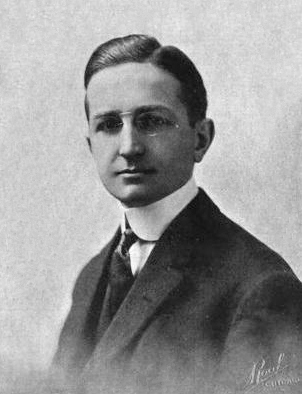
The pipe organ is a musical instrument that produces sound by driving pressurised air through the organ pipes selected from a keyboard. Because each pipe produces a single pitch, the pipes are provided in sets called ranks, each of which has a common timbre, volume, and construction throughout the keyboard compass. Most organs have many ranks of pipes of differing pitch, timbre, and volume that the player can employ singly or in combination through the use of controls called stops.

In music, the organ is a keyboard instrument of one or more pipe divisions or other means for producing tones. The organs have usually two or three, up to five, manuals for playing with the hands and a pedalboard for playing with the feet. With the use of registers, several groups of pipes can be connected to one manual.

Aristide Cavaillé-Coll was a French organ builder. He has the reputation of being the most distinguished organ builder of the 19th century. He pioneered innovations in the art and science of organ building that permeated the profession and influenced the course of organ building, composing and improvising through the early 20th century.

Ernest Martin Skinner was an American pipe organ builder. His electro-pneumatic switching systems advanced organ-building technology in the first part of the 20th century.

The Newberry Memorial Organ is among the largest and most notable symphonic organs in the world. Located in Woolsey Hall at Yale University, the organ contains 197 ranks and 166 stops comprising 12,617 pipes.
The organ repertoire is considered to be the largest and oldest repertory of all musical instruments. Because of the organ's prominence in worship in Western Europe from the Middle Ages on, a significant portion of organ repertoire is sacred in nature. The organ's suitability for improvisation by a single performer is well adapted to this liturgical role and has allowed many blind organists to achieve fame; it also accounts for the relatively late emergence of written compositions for the instrument in the Renaissance. Although instruments are still disallowed in most Eastern churches, organs have found their way into a few synagogues as well as secular venues where organ recitals take place.

The Wanamaker Grand Court Organ, located in Philadelphia, Pennsylvania, is the largest fully functioning pipe organ in the world, based on the number of playing pipes, the number of ranks and its weight. The Wanamaker Organ is located within a spacious 7-story Grand Court at Macy's Center City and is played twice a day Monday through Saturday. The organ is featured at several special concerts held throughout the year, including events featuring the Friends of the Wanamaker Organ Festival Chorus and Brass Ensemble.
George Donald Harrison was responsible for the design of some of the finest and largest pipe organs in the United States. Born in Huddersfield, England, he first worked as a patent attorney in 1914 but after military service he began to pursue an interest in pipe organ building, working with Henry Willis & Sons of London.

Austin Organs, Inc., is a manufacturer of pipe organs based in Hartford, Connecticut. The company is one of the oldest continuously-operating organ manufacturers in the United States. The first instruments were built in 1893 with the Austin Patent Airchest, and many remain in fine playing condition to this day.

The Spreckels Organ Pavilion is an outdoor venue that houses the open-air Spreckels Organ in Balboa Park in San Diego, California. With more than 5,000 pipes, the Spreckels Organ is the world's largest pipe organ in a fully outdoor venue. Constructed for the 1915 Panama–California Exposition, it is located at the corner of President's Way and Pan American Road East in the park.

The Hollywood High School E. M. Skinner Organ Opus 481-A is a pipe organ in Hollywood High School, in Hollywood, Los Angeles, California. The contract for Opus 481 was made in June 1924, shortly after Skinner returned from his second trip to England and France. It took two years to build the organ. The organ was expanded in 1929 by Skinner. When the 1929 Memorial auditorium was built, the organ was moved and also registered as Opus 481-A. Then in 1954 it was placed into storage when the auditorium was refurbished, torn down to its foundation and rebuilt in its present form. Opus 481 is considered to be of musical value, built by the "Cadillac" of symphonic organ builders of the 20th century. The historic organ is an E. M. Skinner Opus 481 of 3-manuals, 39 ranks with chimes and has over 2,600 pipes.

Gordon Turk is an American concert organist. He has played throughout the United States, made two concert tours in Japan, and performed frequently in Europe, including Ukraine and Russia, both as solo organist and with orchestra.

Carol Anne Williams D.M.A., ARAM, FRCO, FTCL, ARCM is a British-born international concert organist and composer, now residing in America. She served from October 2001 and resigned her post in October 2016 as Civic Organist for the city of San Diego, California, performing regularly at the Spreckels Organ Pavilion. She was concurrently serving as the artistic director of the Spreckels Organ Society producing the largest organ festival in North America since 2001. She was formerly the Artist in Residence at St. Paul's Cathedral San Diego.
J. L. van den Heuvel Orgelbouw is a firm of pipe organ builders, based in Dordrecht, Netherlands. The company specialises in the construction of instruments in the French Symphonic tradition.

Edwin Henry Lemare was an English organist and composer who lived the latter part of his life in the United States. He was one of the most highly regarded and highly paid organists of his generation, as well as the greatest performer and one of the most important composers of the late Romantic English-American Organ School.
Thomas Mantle Murray is an American organist, known as an interpreter of Romantic organ music. He was a professor of Music and university organist at the Yale School of Music from 1981 until his retirement in 2019. He is also Principal Organist and Artist in Residence at Christ Church in New Haven, Connecticut.

The Kotzschmar Memorial Organ, usually referred to as the Kotzschmar Organ, is a pipe organ located at Merrill Auditorium in the City Hall of Portland, Maine, United States.

Louisville Memorial Auditorium, located at 970 South Fourth Street, is a concert venue of Greek Revival design. It was dedicated on Memorial Day, May 30, 1929, as a memorial to the people of Louisville who served in World War I. In 1954, the ceiling was lowered and the side balconies were closed off reducing the seating capacity from 2,349 to 1,742 to improve the acoustics.
Diane Meredith Belcher is an American concert organist, teacher, and church musician. She has given a large number of solo recitals throughout the United States and abroad, is a teacher, and has served as Director of Music at Bach Vespers/Holy Trinity Lutheran Church in New York City, Lecturer in Music Theory and Organ at Dartmouth College, in Hanover, New Hampshire, Music Director at Saint Thomas Episcopal Church, Hanover, Co-Organist/Choirmaster at Saint Mark's Episcopal Church in Philadelphia, and head of the Organ Division at Westminster Choir College in Princeton, New Jersey.
The Organ of the Trocadero Palace was built by Aristide Cavaillé-Coll for the 1878 Universal Exhibition at the Palais du Trocadéro in Paris, France. The organ was transferred to the Palais de Chaillot in 1937, before moving to the Auditorium Maurice-Ravel in Lyon in 1977.















